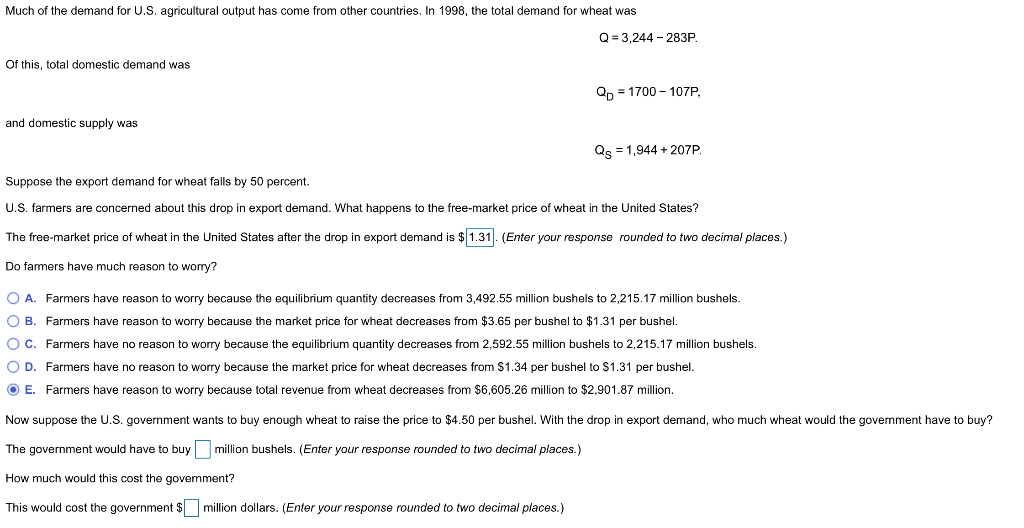Much of the demand for U.S. agricultural output has come from other countries. In 1998, the total demand for wheat was Q = 3,244 - 283P. Of this, total domestic demand was Qp = 1700 - 107P, and domestic supply was Qs = 1,944 + 207P. Suppose the export demand for wheat falls by 50 percent. J.S. farmers are concerned about this drop in export demand. What happens to the free-market price of wheat in the United States? The free-market price of wheat in the United States after the drop in export demand is $ 1.31. (Enter your response rounded to two decimal places.) Do famers have much reason to worry? O A. Farmers have reason to worry because the equilibrium quantity decreases from 3,492.55 million bushels to 2,215.17 million bushels. O B. Farmers have reason to worry because the market price for wheat decreases from $3.65 per bushel to $1.31 per bushel. O C. Farmers have no reason to worry because the equilibrium quantity decreases from 2,592.55 million bushels to 2,215.17 million bushels. O D. Farmers have no reason to worry because the market price for wheat decreases from $1.34 per bushel to $1.31 per bushel. O E. Farmers have reason to worry because total revenue from wheat decreases from $6,605.26 million to $2,901.87 million.
Much of the demand for U.S. agricultural output has come from other countries. In 1998, the total demand for wheat was Q = 3,244 - 283P. Of this, total domestic demand was Qp = 1700 - 107P, and domestic supply was Qs = 1,944 + 207P. Suppose the export demand for wheat falls by 50 percent. J.S. farmers are concerned about this drop in export demand. What happens to the free-market price of wheat in the United States? The free-market price of wheat in the United States after the drop in export demand is $ 1.31. (Enter your response rounded to two decimal places.) Do famers have much reason to worry? O A. Farmers have reason to worry because the equilibrium quantity decreases from 3,492.55 million bushels to 2,215.17 million bushels. O B. Farmers have reason to worry because the market price for wheat decreases from $3.65 per bushel to $1.31 per bushel. O C. Farmers have no reason to worry because the equilibrium quantity decreases from 2,592.55 million bushels to 2,215.17 million bushels. O D. Farmers have no reason to worry because the market price for wheat decreases from $1.34 per bushel to $1.31 per bushel. O E. Farmers have reason to worry because total revenue from wheat decreases from $6,605.26 million to $2,901.87 million.
Chapter3: Supply And Demand: Theory
Section: Chapter Questions
Problem 24QP
Related questions
Question

Transcribed Image Text:Much of the demand for U.S. agricultural output has come from other countries. In 1998, the total demand for wheat was
Q = 3,244 - 283P.
Of this, total domestic demand was
Qn = 1700 - 107P,
and domestic supply was
Qs = 1,944 + 207P
Suppose the export demand for wheat falls by 50 percent.
U.S. farmers are concerned about this drop in export demand. What happens to the free-market price of wheat in the United States?
The free-market price of wheat in the United States after the drop in export demand is $1.31. (Enter your response rounded to two decimal places.)
Do famers have much reason to worry?
O A. Farmers have reason to worry because the equilibrium quantity decreases from 3,492.55 million bushels to 2,215.17 million bushels.
O B. Farmers have reason to worry because the market price for wheat decreases from $3.65 per bushel to $1.31 per bushel.
OC. Farmers have no reason to worry because the equilibrium quantity decreases from 2,592.55 million bushels to 2,215.17 million bushels.
O D. Farmers have no reason to worry because the market price for wheat decreases from $1.34 per bushel to $1.31 per bushel.
O E. Farmers have reason to worry because total revenue from wheat decreases from $6,605.26 million to $2,901.87 million.
Now suppose the U.S. government wants to buy enough wheat to raise the price to $4.50 per bushel. With the drop in export demand, who much wheat would the govemment have to buy?
The government would have to buy million bushels. (Enter your response rounded to two decimal places.)
How much would this cost the government?
This would cost the government $ million dollars. (Enter your response rounded to two decimal places.)
Expert Solution
This question has been solved!
Explore an expertly crafted, step-by-step solution for a thorough understanding of key concepts.
This is a popular solution!
Trending now
This is a popular solution!
Step by step
Solved in 2 steps with 4 images

Knowledge Booster
Learn more about
Need a deep-dive on the concept behind this application? Look no further. Learn more about this topic, economics and related others by exploring similar questions and additional content below.Recommended textbooks for you



Economics (MindTap Course List)
Economics
ISBN:
9781337617383
Author:
Roger A. Arnold
Publisher:
Cengage Learning



Economics (MindTap Course List)
Economics
ISBN:
9781337617383
Author:
Roger A. Arnold
Publisher:
Cengage Learning

Managerial Economics: A Problem Solving Approach
Economics
ISBN:
9781337106665
Author:
Luke M. Froeb, Brian T. McCann, Michael R. Ward, Mike Shor
Publisher:
Cengage Learning

Exploring Economics
Economics
ISBN:
9781544336329
Author:
Robert L. Sexton
Publisher:
SAGE Publications, Inc

Macroeconomics: Principles and Policy (MindTap Co…
Economics
ISBN:
9781305280601
Author:
William J. Baumol, Alan S. Blinder
Publisher:
Cengage Learning